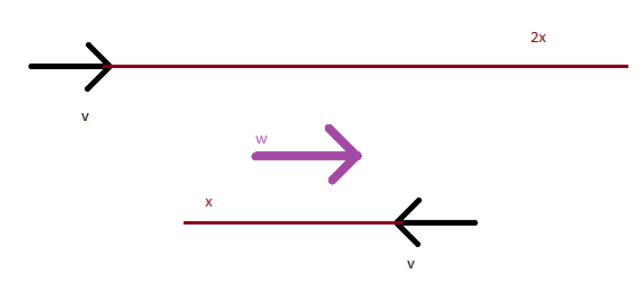
Wind is blowing west to east along two parallel railway tracks. Two trains moving with the same speed in opposite directions have the steam track of one double that of the other. The speed of each train is
(A) Equal to that of the wind
(B) Three times that of the wind
(C) Double that of the wind
(D) Half that of the wind
Answer
218.7k+ views
Hint Draw the length of the first steam track as $2x$, and the second stream track as $x$. Now the first steam track is supported by both the train and the wind velocities and is therefore longer. The second steam track is of the train moving at the same speed in the opposite direction, and is opposed by the wind. We will use the distance formula to compute the speed of each train.
Complete Step by step answer

As shown in the above diagram, the steam track length is drawn in brown.
We will consider the speed of the trains as $v$ each, and the speed of the wind blowing as $w$.
The wind will be supporting the steam to spread and is shown in purple in the diagram.
So, from the first diagram, we get the equation as $v + w = \dfrac{{2x}}{t}$.
Here we assume that the steam length per unit time is equal to the speed of the train and the speed of the wind combined, since both are assisting it.
From the second diagram, we get the equation as $v - w = \dfrac{x}{t}$.
Here we assume that the steam length per unit time is equal to the speed of the train minus the speed of the wind combined, since the length direction is in the direction of the velocity of the train. In this assumption, it is noted that the wind speed is less than the speed of the train as per the diagram, which can be otherwise.
From the above two equations, we get
$v + w = 2(v - w)$
$ \Rightarrow v = 3w$.
Thus, the speed of the train which is $v$, is thrice the speed of the wind, $w$.
Therefore, the correct answer is option (2) Three times that of the wind.
Note: Here we have assumed simply that the steam track is of a certain length and that the wind and train speeds are acting for or against changing the length of the steam track. Therefore the simple equation of speed has been used.
Complete Step by step answer

As shown in the above diagram, the steam track length is drawn in brown.
We will consider the speed of the trains as $v$ each, and the speed of the wind blowing as $w$.
The wind will be supporting the steam to spread and is shown in purple in the diagram.
So, from the first diagram, we get the equation as $v + w = \dfrac{{2x}}{t}$.
Here we assume that the steam length per unit time is equal to the speed of the train and the speed of the wind combined, since both are assisting it.
From the second diagram, we get the equation as $v - w = \dfrac{x}{t}$.
Here we assume that the steam length per unit time is equal to the speed of the train minus the speed of the wind combined, since the length direction is in the direction of the velocity of the train. In this assumption, it is noted that the wind speed is less than the speed of the train as per the diagram, which can be otherwise.
From the above two equations, we get
$v + w = 2(v - w)$
$ \Rightarrow v = 3w$.
Thus, the speed of the train which is $v$, is thrice the speed of the wind, $w$.
Therefore, the correct answer is option (2) Three times that of the wind.
Note: Here we have assumed simply that the steam track is of a certain length and that the wind and train speeds are acting for or against changing the length of the steam track. Therefore the simple equation of speed has been used.
Recently Updated Pages
Two discs which are rotating about their respective class 11 physics JEE_Main

A ladder rests against a frictionless vertical wall class 11 physics JEE_Main

Two simple pendulums of lengths 1 m and 16 m respectively class 11 physics JEE_Main

The slopes of isothermal and adiabatic curves are related class 11 physics JEE_Main

A trolly falling freely on an inclined plane as shown class 11 physics JEE_Main

The masses M1 and M2M2 M1 are released from rest Using class 11 physics JEE_Main

Trending doubts
JEE Main 2026: Application Form Open, Exam Dates, Syllabus, Eligibility & Question Papers

Understanding Uniform Acceleration in Physics

Derivation of Equation of Trajectory Explained for Students

Hybridisation in Chemistry – Concept, Types & Applications

Understanding the Angle of Deviation in a Prism

Understanding Collisions: Types and Examples for Students

Other Pages
JEE Advanced Marks vs Ranks 2025: Understanding Category-wise Qualifying Marks and Previous Year Cut-offs

Units And Measurements Class 11 Physics Chapter 1 CBSE Notes - 2025-26

NCERT Solutions For Class 11 Physics Chapter 8 Mechanical Properties Of Solids

Motion in a Straight Line Class 11 Physics Chapter 2 CBSE Notes - 2025-26

NCERT Solutions for Class 11 Physics Chapter 7 Gravitation 2025-26

Understanding Atomic Structure for Beginners




